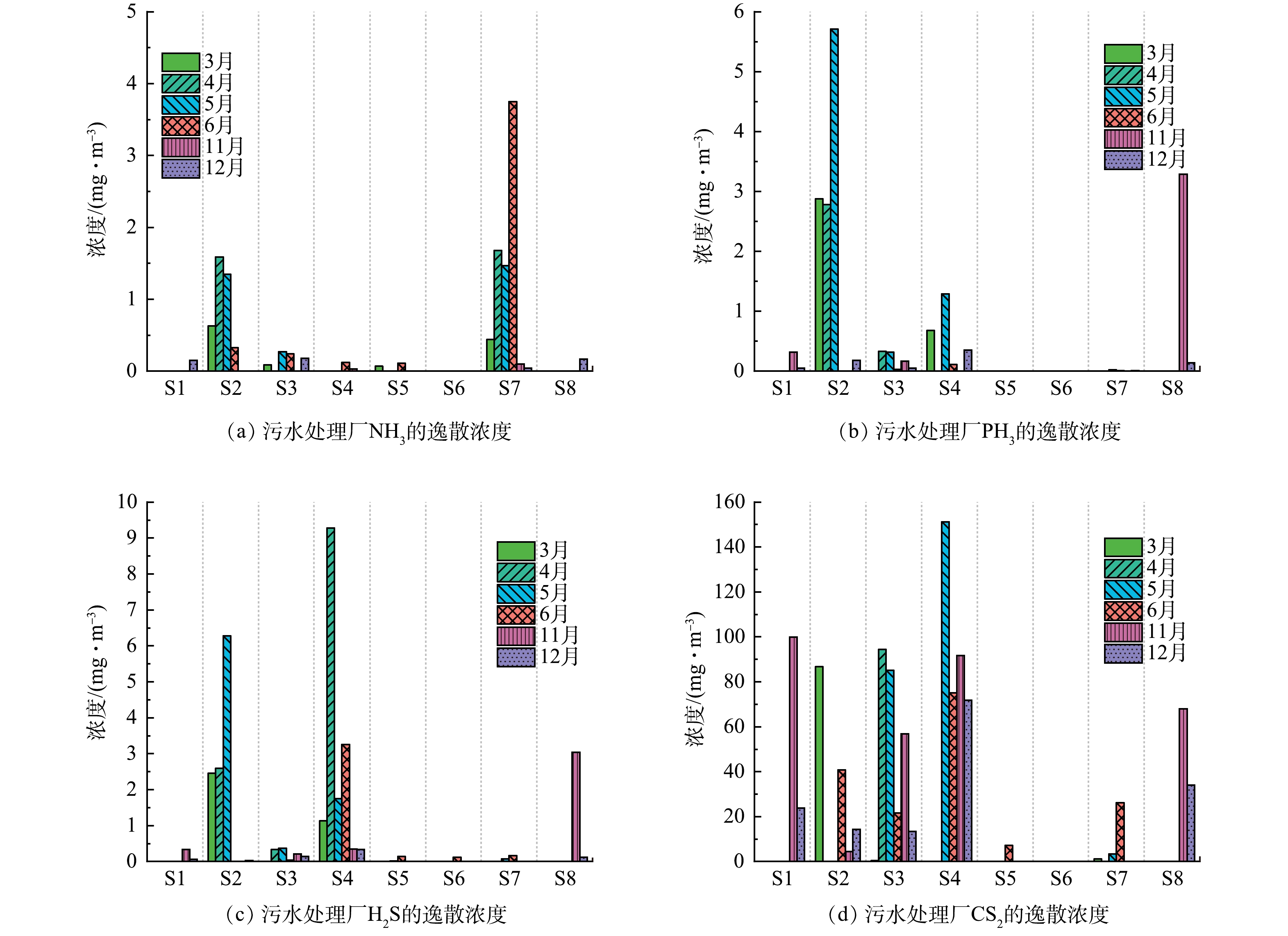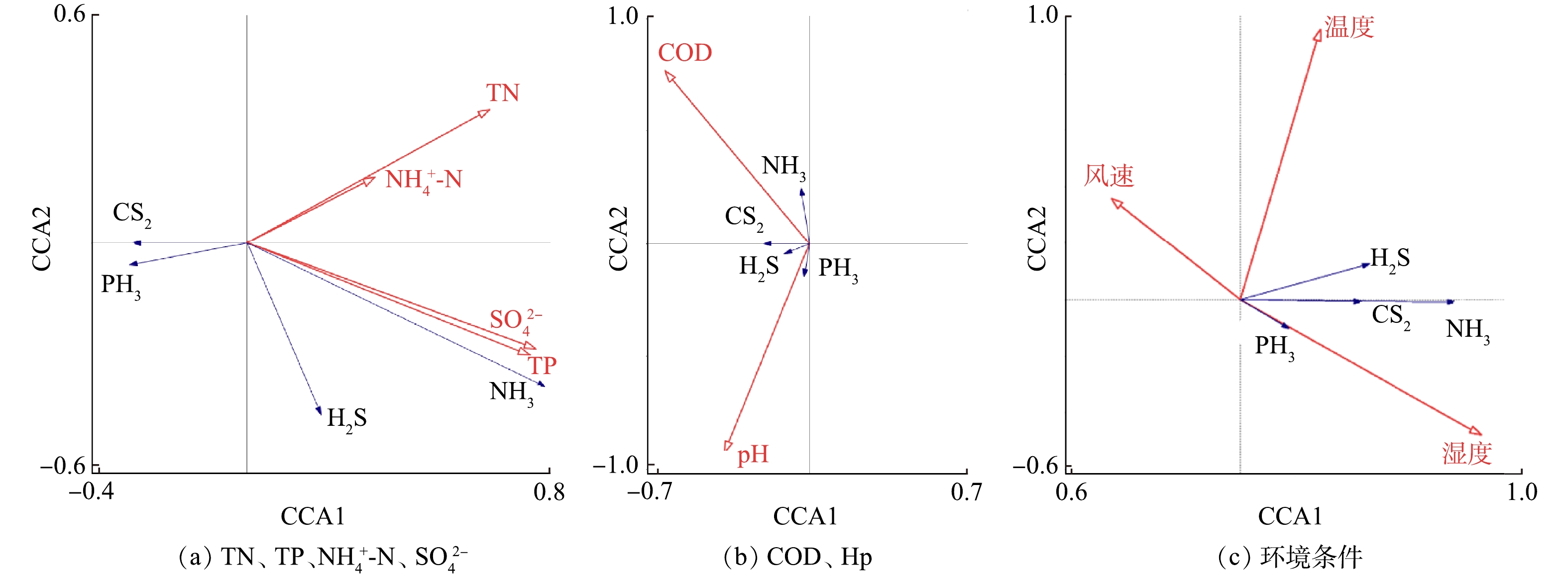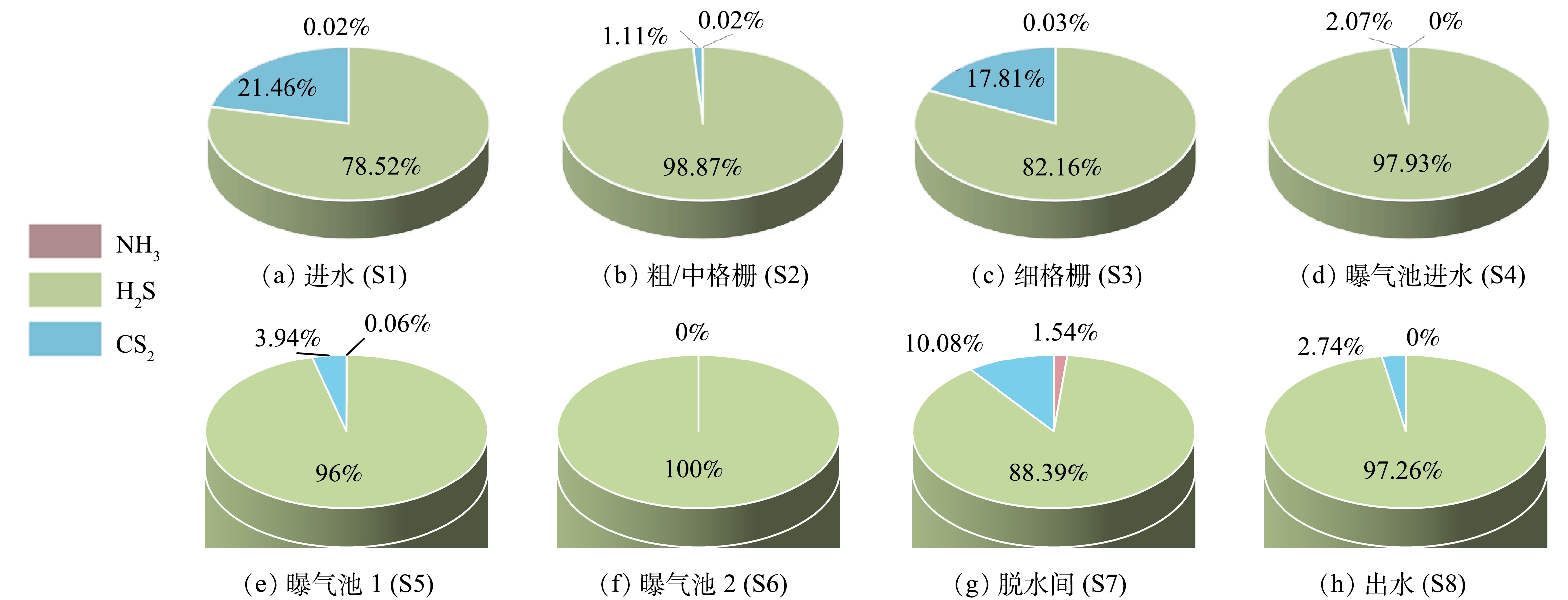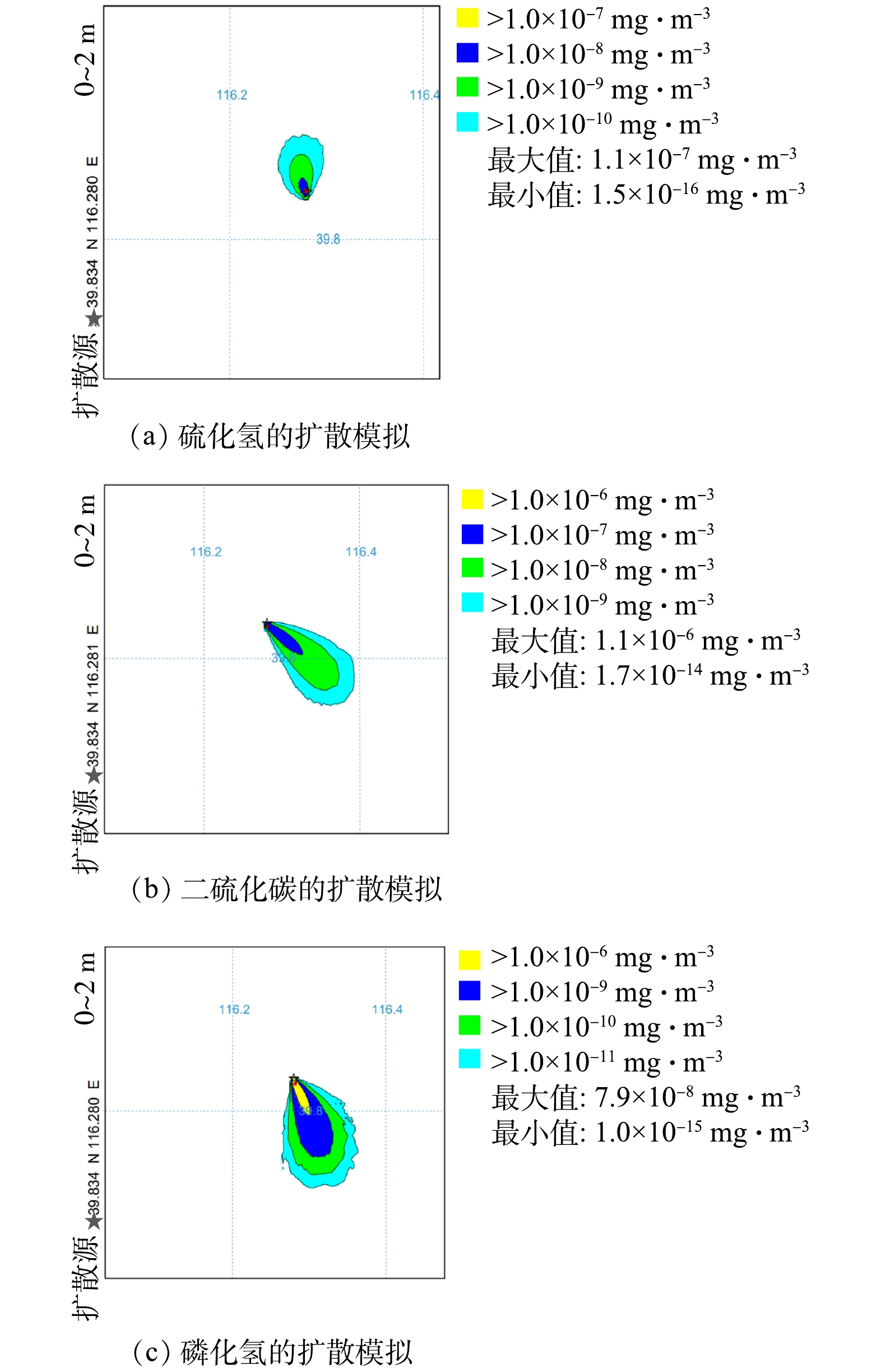-
2021年,我国城市污水处理厂污水处理能力为2.1×109 m3·d−1,污水处理率达到97.89%。污水、污泥处理过程中产生并逸散的恶臭气体、挥发性有机物等气态污染物,影响环境空气质量以及污水处理厂内员工、周边居民的身体健康。2002年我国制定了《城镇污水处理厂污染物排放标准》(GB 18918-2002),严格限制硫化氢、氨、甲烷等气态污染物的排放。有研究[1-2]表明,城市污水处理厂的进水区(进水泵站、格栅间)和污泥处理区(污泥浓缩池、污泥脱水机房)是恶臭气体和挥发性有机物的主要逸散源。硫化氢和氨是常见的恶臭物质[3-4],。排放的VOCs包括烷烃、烯烃、芳香烃、卤代烃、含氧有机物、含氮有机物和含硫有机物等80余种[5-6]。以往的研究主要关注恶臭物质中的硫化氢和氨,较少涉及二硫化碳等有机硫化物以及磷化氢。随着我国污水的排放标准的逐步提高,以及人们对环境质量的要求也显著提高,使得城市污水处理厂排放的空气污染物受到越来越多的关注。A2O是一种典型的污水处理工艺,可常用于二级污水处理或三级污水处理以及中水回用,具有良好的脱氮除磷效果,在我国应用广泛。本研究在北方某座采用A2O工艺的城市污水处理厂设置采样点,监测主要处理单元空气中的硫化氢、氨、二硫化碳、磷化氢等恶臭物质,研究了恶臭随季节的变化特征,明确了其排放源及产生原因,评估了恶臭物质的嗅味影响和健康风险,以期为城市污水处理厂恶臭物质的有效削减和控制提供科学依据。
-
本研究在京津冀地区某一污水处理厂定期采集样品,研究主要污水处理单元恶臭物质逸散的特征。该污水处理厂采用倒置A2O污水处理工艺,处理规模为1.0×105 m3·d−1,服务区域55.8 km2。污水经过粗格栅、细格栅后经水泵提升进入曝气沉砂池,随后进入生化池,处理后的水全部进入再生水厂深度处理。剩余污泥经离心式脱水机脱水后外运。
如图1所示,在污水处理厂主要处理单元共设置了8个臭味气体的采样点,包括进水(S1)、粗/中格栅(S2)、细格栅(S3)、曝气池进水(S4)、曝气池1(S5)、曝气池2(S6)、脱水间(S7)以及出水(S8)。所有采样点设置在距离地面1.5 m处。采样时间3—6月、11—12月,每月采集样品6~8次。
-
1)恶臭物质采集及分析。恶臭物质硫化氢、氨、二硫化碳和磷化氢的监测采用在线气体检测仪(PTM-600,中国)。监测时段为 8:30—10:30 am,每个采样点连续监测20 min,获得的恶臭物质的浓度为连续监测数据的平均值。同时采集对应时间和对应工艺段的污水、污泥样品带回实验室分析。
2)水质及环境条件分析。污水的化学需氧量(COD)和无机离子分别采用多功能消解仪(ET3150B)/分光光度计(DR2800,HACH)和离子色谱仪(DIONEX ICS1000,美国)测定。环境温度和相对湿度采用手持式智能温湿度记录仪(179-TH,USA)监测,风速仪(DeltaOHM HD2303.0,Italy)记录风速。空气温度、相对湿度以及风速分别为6.7~29.1 ℃,23.8%~74.1% 以及0~1.7 m·s−1。
3)计算方法。典范对应分析(canonical correspondence analysis, CCA)方法解析逸散的恶臭气体与环境因素之间的相关性。通过计算气味活性值(odor activity value, OAV),即某种物质的化学浓度与气味检测阈值的比值,确定和分析检出的恶臭物质的嗅觉效应及其气味贡献百分比[7-8]。通过美国环保署公布的空气污染物风险评估方法计算吸入性慢性非致癌风险(hazard quotient,HQ),评估污水厂操作工人恶臭物质的暴露风险[9-10]。
-
如图2所示,监测结果表明,恶臭物质在污水各处理单元的空气中均有检出,逸散水平有明显差异。进水阶段包括进水渠、中格栅、细格栅、曝气池进水等单元。在进水渠空气中检出的氨、硫化氢、二硫化碳和磷化氢的质量浓度分别为0~0.15、0.06~0.33、23.79~99.93和0.05~0.32 mg·m−3。中格栅间内,氨、硫化氢、二硫化碳和磷化氢的质量浓度平均值分别为0.56、1.62、20.88和1.65 mg·m−3。细格栅间空气中氨、硫化氢、二硫化碳和磷化氢的质量浓度分别为0~0.27、0~0.37、0.51~94.33和0~0.33 mg·m−3,平均值分别为0.11、0.16、38.82和0.13 mg·m−3。曝气池进水单元分别有0~0.12 mg·m−3氨、0.33~9.28 mg·m−3硫化氢、0~151.26 mg·m−3二硫化碳和0~1.29 mg·m−3的磷化氢被检出。污水生化处理阶段的采样点包括曝气池1和曝气池2。曝气池1空气中的氨、硫化氢和二硫化碳的质量浓度分别为0~0.11、0~0.14和0~7.14 mg·m−3,平均值分别为0.03、0.02和1.02 mg·m−3。曝气池2空气中只有少量的硫化氢检出,质量浓度为0~0.12 mg·m−3。污泥脱水间空气中氨、硫化氢和二硫化碳等气味物质均有检出,平均浓度分别为1.07、0.03和4.39 mg·m−3。
污水处理厂主要处理单元空气中的恶臭气体主要在进水区,平均质量浓度为0.19 mg·m−3(氨),1.07 mg·m−3(硫化氢),44.32 mg·m−3(二硫化碳)和0.58 mg·m−3(磷化氢),而在污水或污泥处理过程产生的较少。以往的恶臭排放特征的调查和研究的结果表明,城市污水处理厂臭味气体的产生源主要是进水池、格栅间、沉砂池、初沉池及污泥处理系统的储泥池、脱水机房等工艺段或构筑物[1, 11-12]。
污水处理厂预处理单元中的恶臭气体是污水在排水管网中长距离输送时产生的。污水在排水管网中长时间停留,溶解氧逐渐消耗,形成缺氧或厌氧环境。此时,厌氧微生物大量繁殖,污水中的含氮、含硫等物质会转化为氨、硫化氢等恶臭物质。有机物在污水管网中的生物转化研究[13-14]发现,从表面到沉积物中1~2 mm深度的沉积层中,硫化氢的质量浓度迅速增加,表明有硫化氢大量产生,同时,该区域的溶解氧值接近0,处于厌氧状态。管道生物膜中生长的硫酸盐还原菌,以乳酸或丙酮酸等有机物作为电子供体,在厌氧状态下,把硫酸盐、亚硫酸盐、硫代硫酸盐等还原为硫化氢。在无氧条件下,污水中的蛋白质,尿素、氨基酸等这些含氮有机物在微生物的作用下转化成氨。含硫、含磷有机物转化为硫醇、硫醚、二硫化碳(C2S)和磷化氢(PH3)等恶臭物质。当污水流经进水泵站和格栅时,排水管网中产生的恶臭气体大量逸出,形成该工艺段的恶臭污染。此外,污水处理厂格栅截留的漂浮物中含有较多的有机物,格栅渣的堆积也会导致有机物的厌氧发酵产生恶臭物质。另外,格栅间是相对密闭的空间,空气流动较少,恶臭物质积聚在格栅间内,导致格栅间空气中的恶臭浓度明显高于其他处理单元。剩余污泥在浓缩、堆置过程中,污泥内部形成厌氧环境,大量有机物进一步发酵、分解,产生NH3和挥发性有机硫等恶臭物质。污泥脱水过程中,恶臭物质从污泥中释放,使污泥处理单元也成为一个恶臭气体的排放源。污水生化处理阶段采用倒置A2O工艺,其中好氧段采用活性污泥法,微孔曝气方式提供生化反应所需的氧气,因此,曝气池内是好氧环境,水中的氨、硫化氢以及有机物等物质在该处理单元被氧化为硝酸盐、硫酸盐以及二氧化碳等物质。并且,生化池位于室外,空气流动加速气体扩散,使生化池的恶臭浓度值最低。
-
在污水输送和处理过程中,恶臭气体的产生与排放与污水处理厂的进水水质以及环境条件(如光照强度、空气温度、相对湿度和风速)等因素密切相关[13]。本研究发现进水阶段的各处理单元是污水处理厂恶臭物质的主要逸散源,因此,进一步研究了进水水质(COD、氨氮、总氮、总磷、pH等),对各种检出的恶臭物质逸散水平的影响,并分析其相关性。结果表明,硫化氢的释放与进水中硫酸盐的含量呈显著正相关,这是由于输水管道内呈缺氧环境,污水中的硫酸盐在厌氧菌作用下被还原成硫化物,进一步产生硫化氢。以往的研究也报道了类似的结果[14-15]。此外,空气中氨的浓度与进水中的氨氮和总氮正相关(图3(a))。根据亨利定律,在一定温度下,当液面上的一种气体与溶液中所溶解的该气体达到平衡时,该气体在溶液中的浓度与其在液面上的平衡分压成正比[16]。污水从输送管道中流出进入进水渠、格栅等处理工艺段,气相的分压降低,气水平衡发生改变,水中的氨氮释放到周围空气中。因此,进水氨氮浓度高时,在进水区的空气中会有较多的氨检出。以往的研究表明,COD值高的污水,进入水厂后会释放较多的挥发性有机物。二硫化碳是挥发性有机硫化物,其逸散浓度与污水的COD呈现正相关(图3(b))。磷化氢微溶于水,其水溶液呈弱碱性。当pH增大,水溶液呈碱性时,有更多的磷化氢因溶解度降低而存在于气相中,因此呈现出其与pH呈正相关的现象。
恶臭物质的逸散浓度在各个季节也有明显差异。污水处理厂位于华北地区,每年的3~5月为春季、6~8月为夏季,9~11月为秋季,12~次年2月为冬季。恶臭物质的逸散受温度、相对湿度、风速等环境条件影响。相关性分析显示,氨、硫化氢、C2S 以及PH3的逸散浓度与风速均呈负相关关系,与环境温度、相对湿度呈正相关关系(图3(c))。在温度、相对湿度适宜且平均风速较小的夏季,污水处理各单元空气中恶臭物质的检出较多。
-
恶臭物质影响分析包括恶臭物质对人体感官和健康两方面的影响分析。恶臭物质的嗅觉效应及贡献率通过计算其气味活性值(OAV)在总气味活性值中的占比进行评估,以识别主要的气味物质,计算结果如图4所示。主要的致臭物质为硫化氢,其在各工艺段的异味贡献率在78%~100%。在进水阶段的空气中,硫化氢和二硫化碳是引起异味的主要化合物,其异味贡献率分别为78.52%和21.46%。除硫化氢外,二硫化碳是污泥脱水间的主要异味物质,其异味贡献率为10.08%。
氨、硫化氢、二硫化碳以及磷化氢均不是致癌物质,但是,长期接触会导致慢性致病。硫化氢是一种强烈的神经毒素,对粘膜有强烈刺激作用。低浓度的硫化氢对眼、呼吸系统及中枢神经都有影响。硫化氢是细胞色素氧化酶的强抑制剂,能与线粒体内膜呼吸链中的氧化型细胞色素氧化酶中的三价铁离子结合,而抑制电子传递和氧的利用,引起细胞内缺氧,造成细胞内窒息。通过吸入或皮肤接触进入人体后,氨在人体组织内遇水生成氨水,可以溶解组织蛋白质,与脂肪起皂化作用。氨水能破坏体内多种酶的活性,影响组织代谢。CS2是一种多系统亲和毒物,对神经、心血管、胃肠道等系统均有毒害作用。评价人体对这些恶臭物质的暴露风险,有助于相关部门明确污水厂气体污染物控制的优先次序、加强风险管理、保障现场操作人员和周边居民的身体健康。慢性致病风险值平均为0.33(氨),0.039(硫化氢),3.49(二硫化碳)和4.87(磷化氢)。其中,磷化氢的平均风险值最高。根据美国环保署的相关定义,对于慢性毒害,当HQ<1时,其风险可以忽略;当HQ>1时,长期暴露导致的危害应引起关注。磷化氢和二硫化碳是主要的具有潜在慢性致病风险的物质。
-
污水处理厂的生化处理池和二沉池等污水处理池均为敞开式,未进行加盖密封处理。在这些工艺段逸散的恶臭气体,不仅在厂区弥漫,还会随风向周边扩散,影响污水厂厂外区域的空气质量。HYSPLIT模型是一种用于气溶胶和气体传输模拟的大气扩散模型,被广泛应用于空气质量监测、环境污染、气候变化等领域。利用HYSPLIT模型分别模拟了在曝气池进水(S4)、曝气池(S5和S6)以及出水(S8)等露天点位,硫化氢、二硫化碳和磷化氢的传输和扩散轨迹。图5反映了3种气体物质释放浓度最大时的模拟结果。硫化氢的扩散方向呈由南向北椭圆形分布(图5(a));10 min后,距离厂界为0.3 km时,其质量浓度降低至1.0×10−7 mg·m−3,影响范围为0.21 km2。二硫化碳和磷化氢的扩散趋势呈西北到东南椭圆形分布(图5(b)和图5(c)),10 min后,二硫化碳的质量浓度为1.1×10−6 mg·m−3 (距离厂界0.286 km),磷化氢的质量浓度为7.9×10−8 mg·m−3 (距离厂界0.25 km)。二硫化碳和磷化氢的影响范围分别为0.20 km2 和 0.14 km2。污水厂内产生的恶臭物质向周边随风扩散10 min之后,距离厂界300 m处空气中的硫化氢和二硫化碳的浓度均低于《恶臭污染物排放标准GB 14554-93》规定的周界恶臭污染物浓度限值。磷化氢慢性致病的风险值也降低至3.13×10−6(远低于1),属于可忽略的范围。
-
1)污水处理厂的进水区,尤其中格栅和曝气池进水单元是恶臭物质的主要逸散源,其逸散浓度与进水水质相关。周围空气中恶臭物质的浓度按污水处理单元的顺序依次降低。污水在该污水处理厂经过有效的处理,很少或几乎不释放恶臭物质。在温度、相对湿度适宜且平均风速较小的夏季,恶臭物质的检出相对较多。
2)硫化氢和二硫化碳是臭味活性物质的主要贡献物质。二硫化碳和磷化氢是主要的具有潜在慢性致病风险的物质。由于空气稀释的作用,污水处理厂检出的恶臭物质对距离厂界300 m以外的区域,造成的影响极小。但对于长期在污水处理厂工作的职工,污染物的累积会增加暴露风险。因此,污水处理厂工作人员在上述污水处理工艺段操作时,需要做好相应的防护。
3)未来,在污水处理过程中,建议采用适宜的方法如加盖密闭恶臭物质的主要逸散源、建立相应的处理设施等削减和控制污水处理产生的气体污染物。
A2O工艺城市污水处理厂恶臭物质逸散特征及风险评估
Characteristics and risk assessment of odors released from a wastewater treatment plant with A2O treatment process
-
摘要: 污水处理过程释放的大量恶臭气体对人体感官和健康产生不利影响。本研究在城市污水处理厂设置采样点,研究主要污水处理单元恶臭物质的逸散特征。结果表明,恶臭物质的排放主要集中在进水区,硫化氢、氨、二硫化碳、磷化氢的平均浓度分别为1.07、0.19、44.32和0.58 mg·m−3。污泥脱水间也是恶臭物质氨的主要释放源。硫化氢是主要的致臭物质,其在各工艺段的异味贡献率超过75%。二硫化碳和磷化氢的慢性致病风险较高,有必要采取相应的措施削减和控制其在污水处理厂内的影响。在厂界外300 m处,二硫化碳和磷化氢的慢性致病风险值可忽略,同时,硫化氢、氨、以及二硫化碳的厂界浓度均远远低于《恶臭污染物排放标准》(GB 14554-93)规定的相关限值。Abstract: The large amount of malodorous gases released by the sewage treatment process adversely affects the human senses and health. In this study, sampling points were set up in urban sewage treatment plants to study the fugitive characteristics of odorous substances in major sewage treatment units. The results showed that the discharge of malodorous substances was mainly concentrated in the influent zone, and the average concentrations of hydrogen sulfide, ammonia, carbon disulfide and phosphine were 1.07, 0.19, 44.32 and 0.58 mg·m−3, respectively. The sludge dewatering room was also the main source of the release of the malodorous substance ammonia. Hydrogen sulfide was the main odor-causing substance, and its odor contribution rate in each process section exceeded 75%. The risk of chronic disease of carbon disulfide and phosphine was high, and measures are necessary to reduce and control their impact in wastewater treatment plants. At 300 meters outside the plant boundary, the chronic pathogenic risk values of carbon disulfide and phosphine were negligible, and the concentrations of hydrogen sulfide, ammonia and carbon disulfide in the plant boundary were far below the relevant limits stipulated in the Odorous Pollutant Emission Standard (GB14554-93).
-
Key words:
- wastewater treatment /
- odors /
- emission characteristics /
- olfactory effect /
- risk assessment
-
[1] 刘建伟, 李琳, 赵珊, 等. 恶臭气体生物处理新技术与应用实例[M]. 北京: 中国环境出版集团, 2020. [2] 孙德智, 刘俊新, 李若愚, 等. 城镇污水处理空气污染物排放特征与监管技术[M]. 北京: 科学出版社, 2022. [3] 黄力华,刘建伟,夏雪峰,等. 城市污水处理厂典型气体污染物产生特性研究[J]. 科学技术与工程, 2015, 15(3): 295-299. doi: 10.3969/j.issn.1671-1815.2015.03.059 [4] 林坚,李琳,刘俊新,等. 城市污水厂主要处理单元恶臭及挥发性有机物的逸散[J]. 环境工程学报, 2016, 10(5): 2329-2334. doi: 10.12030/j.cjee.201412148 [5] 刘舒乐,王伯光,何洁,等. 城市污水处理厂恶臭挥发性有机物的感官定量评价研究[J]. 环境科学, 2011, 32(12): 3582-3587. doi: 10.13227/j.hjkx.2011.12.023 [6] ASADI M,MCPHEDRAN K. Estimation of greenhouse gas and odour emissions from a cold region municipal biological nutrient removal wastewater treatment plant[J]. Journal of Environmental Management, 2021, 281: 111864. doi: 10.1016/j.jenvman.2020.111864 [7] WU C,LIU J,ZHAO P,et al. Evaluation of the chemical composition and correlation between the calculated and measured odour concentration of odorous gases from a landfill in Beijing,China[J]. Atmospheric Environment, 2017, 164(9): 337-347. [8] NAGATA Y. Measurement of odor threshold value of odor substances by triangle odor bag method[C]//Meeting of the Japan Society of Air Pollution. 1988. [9] DAI H,JING S,WANG H,et al. VOC characteristics and inhalation health risks in newly renovated residences in Shanghai,China[J]. Science of the Total Environment, 2016, 577: 73-83. [10] US EPA, Air Toxics Risk Assessment Reference Library:Technical Resource Manual[M]. Washington: United States Environmental Protection Agency, 2004. [11] 朱国营,刘俊新. 污水处理厂的生物滤池除臭技术[J]. 中国给水排水, 2003, 19(8): 23-25. doi: 10.3321/j.issn:1000-4602.2003.08.007 [12] 李慧丽,张建新,张荣兵,崔希龙,文洋,李琳. 污水厂生物除臭设施运行及影响因素的研究[J]. 环境工程学报, 2007, 1(5): 25-30. doi: 10.3969/j.issn.1673-9108.2007.05.006 [13] JIANG G,MELDER D,KELLER J,et al. Odor emissions from domestic wastewater:A review[J]. Critical Reviews in Environmental Science and Technology, 2017, 47(17): 1581-1611. doi: 10.1080/10643389.2017.1386952 [14] LIANG Z,SUN J,CHAU H,et al. Experimental and modelling evaluations of sulfide formation in a mega-sized deep tunnel sewer system and implications for sewer management[J]. Environment International, 2019, 131: 105011. doi: 10.1016/j.envint.2019.105011 [15] 王智超,席劲瑛,欧阳云,等. 城市污水厂H2S排放浓度与水质和泥质指标的相关性[J]. 环境科学研究, 2013, 26(9): 989-994. [16] JOHAN W G,PAUL G M H. Biotechniques for air pollution control[J]. Biodegradation, 1993(4): 283-301. -





 下载:
下载:





